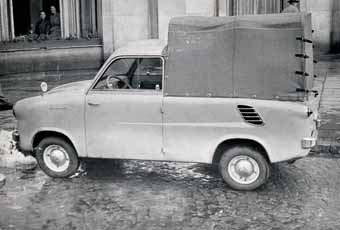



Page created in 1995
In the fall of 1956 work started on two prototypes of an economy/family car. They were completed in 1957 in an experimental sieries of 17. In 1958, after extensive testing, 100 of these were constructed in pre-production form and distributed among the public for evaluation purposes.
 1957 prototype
MR-300
1957 prototype
MR-300 
From late 1958 to 1960 a total of 1728 of the minicars, virtually unmodified from the evaluation version, were produced under the name Mikrus MR300 by WSK (Wytwornia Sprzetu Komunikacyjnego, which translates to Transport Equipment Plant or Communications Plant). The factory which produced the Mikrus automobile and was responsible for most of its development was located in the town of Mielec in Poland, it still exists to this day. The WSK factory in Rzeszow was responsible for engine design.
| Among the mentioned experimental series of 17 were two examples of a rather-pretty cabriolet, but alas that version did not reach production. An interesting prototype of a Mikrus pick-up constructed later in 1960 suffered a similar fate. |  |
The Mikrus was a well-constructed automobile for its time, powered by a rear-mounted 2-cylinder, 2-stroke, 300cc engine which propelled it to a respectable 90 km/h. Its purpose was to provide simple and inexpensive transportation for a family with 2 children. It was a great vehicle for those who could not afford or didn't need a bigger car with more features. It was also remarkably durable and of good quality due to the use of aeroplane-grade materials.
| A Mikrus, among other micros, at Muzeum Motoryzacji
in Warsaw, Poland. Photo by Horacio Moreno. |
Quite a number of the MR-300s are still on the road today, some with many thousands of kilometres on the clock, but rarely does one feature all-original equipment, simply because most parts are not available anymore. For instance, some owners were forced to modify the fenders so that more easily obtainable tires (bigger than the original 10") could be installed.
 |
A very nice example of a production Mikrus, found at Muzeum Techniki in Warsaw, Poland. |  |
The Mikrus' unsynchronized gear change needed a bit of getting used to but this more or less was something one had to put up with in quite a number automobiles, especially inexpensive ones, of the day. And the 15 hp power output, it can be argued, was considerably less than other vehicles but the Mikrus was also a relatively light car at 450 kg. Such a low mass was possible due to the extremely simple and rudimentary nature of the Mikrus. One of the things being that luggage had to be loaded from the inside, as there was no access to the trunk from the outside.
A Mikrus with a larger 400cc engine and presumably some improvements and additions was planned, but a theory exists claiming that the Soviets (this was the cold war era, after all) did not allow this to go through since it would have most likely been able to compete with the Ukrainian-made Zaporozhets (which was initially being powered by a four-cycle 746cc V4). It is interesting to consider what the "MR-400" (presumably) would have been like, taking into account that the Mikrus MR-300 was what could be considered a somewhat experimental automobile and an important one for Polish motoring history.
| Gregory Grden's car (with 90% original parts) is a very nice example of the Mikrus. It is shown here with the owner at a huge gathering of almost 200 micro and mini cars near Chicago where it received 1st prize in the under-400cc category (see www.microcar.org for more info). It is the only one on the American continent and arrived there in 2000 on the wings of a LOT (the Polish airlines) airplane. |

|
See Detailed technical and other information for more about the MR-300 Mikrus.
Currently WSK "PZL-Mielec" is a holding company that controls Melex, a maker of electric vehicles (i.e. golf carts), and Gepard Ltd., which produces a pretty limited-production Rover-V8-powered old-British-style (think of Morgans) roadster with the name of Gepard.